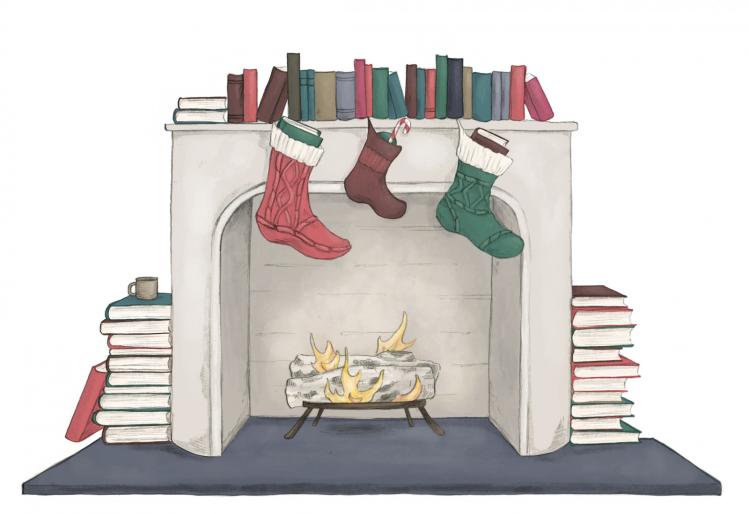
I’ve received many delightful doorstops at Christmas—novels and memoirs mostly—but I’d also like to make the case for a slender volume of fiction as the perfect gift. The best short fiction, no matter how distressing or depressing, creates possibility: the tale is quickly told, we readers are jolted, our angle of vision shifts. What better time for a new angle than Christmas, when our focus is on that most transformative of stories, the Nativity?
And what better time to briefly retreat from clamorous gatherings to the contemplative cloister of a short story? We can hide away for twenty pages and return to the Christmas feast guilt-free. In Hilary Mantel’s superb collection, Learning to Talk (Henry Holt & Co., $19.99, 176 pp.), the stories all take place in the 1950s and ’60s in the grimy industrial North of England—a setting that seems especially apt for Christmastime, when we celebrate a straitened family in a landscape made bleak by poverty. The fictional family Mantel follows in these six stories is, however, no holy family: the mother has moved her lover into the house and her husband into a bedroom down the hall. It’s left to the eldest child to bear witness to the ensuing moral chaos by narrating their story with precise, odd details, all faithful to the skewed understanding of children. Increasingly aware of class and bias against Irish families like hers, the child is learning to talk properly in elocution classes, which Mantel skewers deliciously.
Learning to Talk may also provide some solace to readers stunned by Mantel’s sudden death in September. Best known for her Booker Prize–winning Wolf Hall and Bring Up the Bodies, she is as bracing a story writer as she is a novelist; a previously released collection, The Assassination of Margaret Thatcher, is also a knockout. The “new” collection was released in the United States shortly before Mantel’s death, though it was published in the United Kingdom in 2003, the same year as her compelling memoir, Giving Up the Ghost. This edition includes a brief preface in which Mantel calls attention to the “autoscopic” nature of these stories—yes, they tell her family’s story, but they don’t sensationalize the central drama: it’s too hard to believe anyway, she argues. Though Mantel’s tongue is tart, she names each and every struggle the family endures, an exercise in narrative empathy told in economic rather than emotional terms. In the same story, the narrator says, “I like to understand history through figures and percentages of these figures, through knowing the price of coal and the price of corn, and the price of a loaf in Paris on the day the Bastille fell.”
This fidelity to precise representation of a remembered or imagined world, rendered compactly, is also Alexander MacLeod’s method, though the two writers could not be more stylistically different. Mantel’s prose is dense with imagery, metaphor, and the constant threat that dark poetry might break out any minute (“the murky sheen of carnation water two days old. Reek of armpits, rattling cough”). MacLeod, by contrast, is lean, direct, subtle. A Mantel story starts at a high pitch; a MacLeod story builds mysteriously, magically. His casual tone and graceful, straightforward prose sneak up on the reader with appealing modesty. (Full disclosure: MacLeod was a thesis student of mine twenty-five years ago, but I didn’t realize he had published a second collection until I heard him reading one of these stories on a New Yorker podcast.) Each of the eight stories in Animal Person (Farrar, Straus and Giroux, $27, 256 pp.) introduces a new setting (mostly in Canada, where MacLeod is a much-admired literary presence), a new set of characters, a new surprise. In the opening story, “Lagomorph,” which won an O. Henry Award, the narrator says of understanding rabbits: “You just have to be patient and pay close attention and try hard to find the significance in what very well could be their most insignificant movements,” an instruction that serves equally well as a guide to reading these stories. “Lagomorph” explores the connection between human and animal but also the animal in its narrator, whose wry voice guides us through the dissolution of his marriage and the enlargement of his heart. In “The Closing Date,” a young couple checks into a cheap motel with their four-year-old daughter and meets a serial killer, who brings them all Mr. Freeze pops on a sweltering summer day. The familiar language of real-estate closings and marital sex masks the profound change he brings to their lives: for years to come, they will ponder their role in a murder that takes place in the room next door as they are making love. In another story, a young boy barely escapes the sexual advances of a playmate’s father. Even the plots that build to the greatest sense of menace, however, are shot through with narrative generosity, an interest in killers and predators as well as victims and witnesses, a longing to understand the unfathomable and sometimes the seemingly unredeemable.
The last slender volume on my list isn’t, strictly speaking, a novella, nor is it new: Sigrid Nunez’s The Friend (Riverhead Books, $16, 224 pp.) was published in 2018, when it also won the National Book Award, but I have found myself re-reading it annually since then—besides, what better segue from a collection called Animal Person to a brief novel about a woman who adopts a dead friend’s Great Dane and moves him into an impossibly small apartment? The Friend is a hyper-literary novel, full of references to philosophers, novelists, and creative-writing workshops, but it is not—as so many novels fitting that description are––obnoxious. It is, rather, charged with mystery and wonder as the narrator ponders her friend’s suicide, the compulsion to write, the beauty of a suffering animal. Like Mantel, Nunez can be scathing in her wit; like MacLeod, she is drawn to the badly behaved. All three writers are dead serious about the power of fiction at its most succinct. I can’t think of better Christmas wonders.
Please email comments to [email protected] and join the conversation on our Facebook page.
Previous Story
‘We Are Not Yet Christians’
Next Story
Conscience, Contracts & Covenants


